Universal Technical Institute Bundle
Can Universal Technical Institute Maintain Its Momentum?
Established in 1965, Universal Technical Institute (UTI) has evolved from an automotive training pioneer to a leading provider of technical education across various in-demand fields. With a current market capitalization of $1.93 billion USD as of June 2025, UTI's strategic growth initiatives are under intense scrutiny. This analysis explores UTI's ambitious 'North Star Strategy' and its implications for future success.
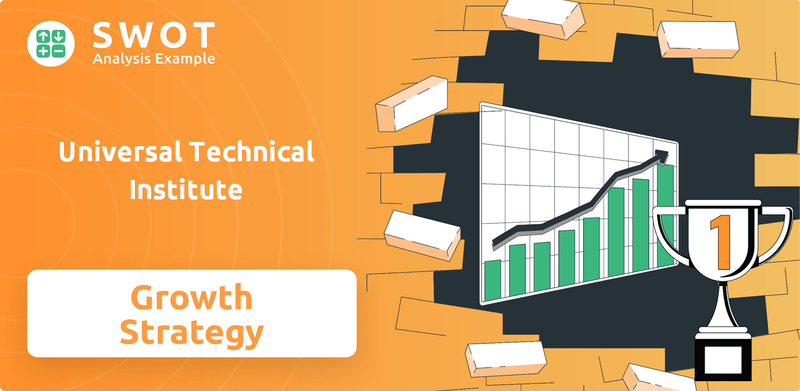
This deep dive into UTI's Universal Technical Institute SWOT Analysis will uncover the core strategies driving its expansion, including new program launches and campus openings designed to meet the rising demand for skilled professionals. We'll examine the company's financial projections, technological advancements, and potential hurdles, providing a comprehensive overview of UTI's trajectory. Explore the career prospects and assess whether UTI is a good school for your technical training needs.
How Is Universal Technical Institute Expanding Its Reach?
The company is actively executing a comprehensive expansion strategy, primarily through its 'North Star Strategy,' now in Phase II. This strategy focuses on increasing capacity and introducing new programs at existing campuses. The goal is to meet the growing demand for skilled trades and healthcare education, diversifying revenue streams and adapting to industry changes.
A key aspect involves expanding current program offerings and adding new ones. This includes adding dental hygiene operatories at Concorde campuses and welding booths at UTI facilities. Furthermore, the company plans to introduce programs from its current portfolio to more campuses, such as the recent addition of an aviation program at Long Beach and HVACR at Avondale. The company is also launching entirely new, in-demand programs.
Geographical expansion is another critical element, with plans to open at least two new campuses annually between fiscal years 2026 and 2029. These initiatives are driven by the increasing demand for skilled trades and healthcare education. The company is also forming new partnerships to provide additional career transition and placement opportunities for students.
UTI is increasing the capacity of existing programs and introducing new offerings at current campus locations. For instance, UTI plans to add dental hygiene operatories at Concorde campuses and additional welding booths at UTI facilities. This expansion aims to accommodate more students and meet growing industry demands.
The company intends to add programs from its current portfolio to more existing campuses, such as the recent addition of an aviation program at Long Beach and HVACR at Avondale. UTI is also launching entirely new, in-demand programs. These new programs are designed to align with current market needs and provide students with relevant skills.
Geographical expansion is another critical element, with plans to open at least two new campuses annually between fiscal years 2026 and 2029. Three new campuses are slated to open in 2026, including a Heartland-Concorde co-branded campus, a fully optimized UTI campus in Atlanta, and an inaugural skilled trades-focused UTI campus in San Antonio, Texas. This expansion will increase accessibility for students across different regions.
The consolidation of MIAT-Houston and UTI-Houston operations, beginning in fiscal 2024 and completing in early fiscal 2025, is also part of this strategic optimization. These efforts aim to streamline operations and improve efficiency. Such optimizations are crucial for long-term sustainability and growth.
The company's expansion initiatives are driven by the increasing demand for skilled trades and healthcare education, aiming to diversify revenue streams and stay ahead of industry changes. The company has also announced new partnerships to provide additional career transition and placement opportunities for students. To understand the competitive landscape, you can review the Competitors Landscape of Universal Technical Institute.
- Plans to introduce a minimum of six new programs annually across Concorde and/or UTI campuses starting in fiscal year 2025.
- Nine new programs have already been announced for fiscal 2025.
- Three new campuses are slated to open in 2026.
- Consolidation of MIAT-Houston and UTI-Houston operations.
Universal Technical Institute SWOT Analysis
- Complete SWOT Breakdown
- Fully Customizable
- Editable in Excel & Word
- Professional Formatting
- Investor-Ready Format
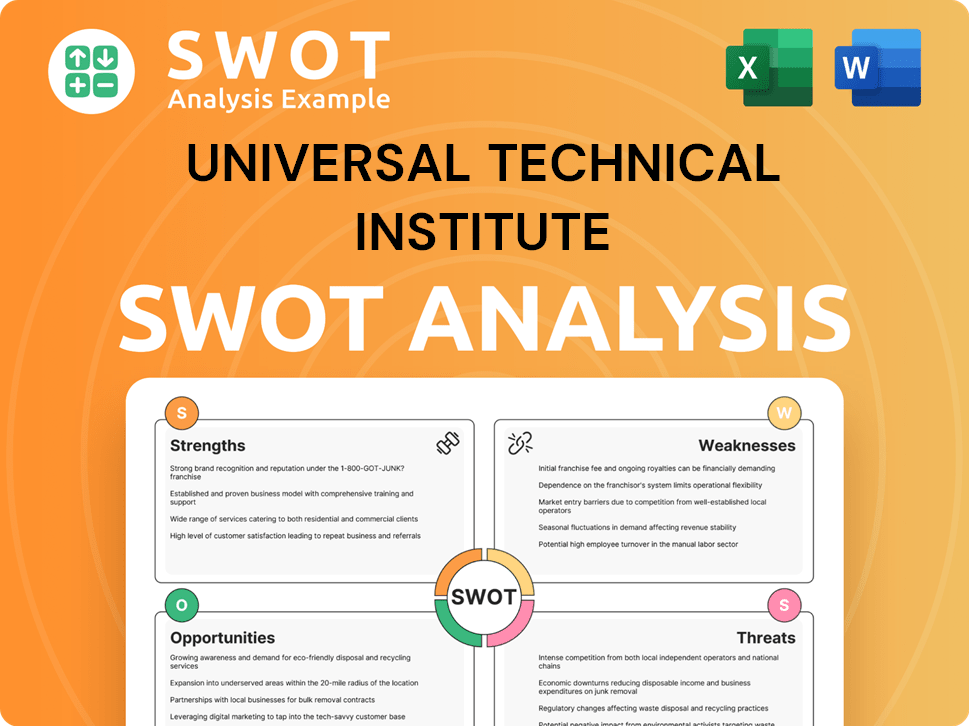
How Does Universal Technical Institute Invest in Innovation?
Universal Technical Institute (UTI) is actively leveraging innovation and technology to foster sustained growth. This strategy focuses on digital transformation, curriculum development, and strategic partnerships to meet evolving industry demands. The company's commitment to innovation is evident in its continuous efforts to update and expand existing programs while developing new ones.
UTI's approach to digital transformation is supported by the recent appointment of Adrienne DeTray as Chief Information Officer. She will lead the development of a modern technology and data platform. This platform is designed to enhance operational visibility and improve the student experience. The company also emphasizes industry collaboration, ensuring training programs align with current industry needs and emerging technologies.
The launch of new programs, such as the Heating, Ventilation, Air Conditioning, and Refrigeration (HVACR) program, which began in March 2025 at the Orlando campus, and the Electrical Electronics and Industrial Technology (EEIT) program, demonstrates UTI's responsiveness to market demands. The EEIT program, a 12-month course, is available at UTI's Xtend and Mooresville campuses, preparing students for entry-level careers in low-voltage electronics and high-voltage electrical systems. These initiatives reflect UTI's dedication to providing relevant and up-to-date training.
UTI is investing in digital transformation to improve operational efficiency. This includes building a modern technology and data platform. The platform aims to enhance both operational visibility and the student experience.
UTI continuously updates and expands its programs. New programs like HVACR and EEIT are launched to meet industry demands. The curriculum is designed to align with current industry needs and emerging technologies.
UTI collaborates with industry leaders to develop its curriculum. Approximately 90% of the curriculum is developed in partnership with companies like BMW, Ford, and General Motors. These partnerships ensure that training programs are relevant and up-to-date.
The focus on industry partnerships ensures that UTI programs are aligned with current industry needs. This includes training in new technologies like EV and BHEV in the automotive sector. This alignment helps graduates secure jobs in their fields.
UTI is actively expanding its program offerings to meet market demands. The launch of the HVACR program in Orlando and the EEIT program at Xtend and Mooresville campuses are examples of this expansion. This expansion aims to provide students with more career options.
UTI is integrating technology to improve the student experience. The new technology and data platform will enhance operational visibility. This integration supports UTI's commitment to providing a modern learning environment.
UTI's commitment to innovation is evident through several key initiatives. These initiatives are designed to keep the school at the forefront of technical education and provide students with the skills needed for successful careers. The focus on digital transformation and industry partnerships is critical for long-term growth.
- New Program Launches: The introduction of the HVACR program in Orlando and the EEIT program at Xtend and Mooresville campuses.
- Digital Platform Development: The build-out of a modern technology and data platform led by the new Chief Information Officer.
- Industry Collaboration: The continued partnerships with industry leaders to ensure curriculum relevance.
- Curriculum Updates: Ongoing efforts to update and expand existing programs.
Universal Technical Institute PESTLE Analysis
- Covers All 6 PESTLE Categories
- No Research Needed – Save Hours of Work
- Built by Experts, Trusted by Consultants
- Instant Download, Ready to Use
- 100% Editable, Fully Customizable
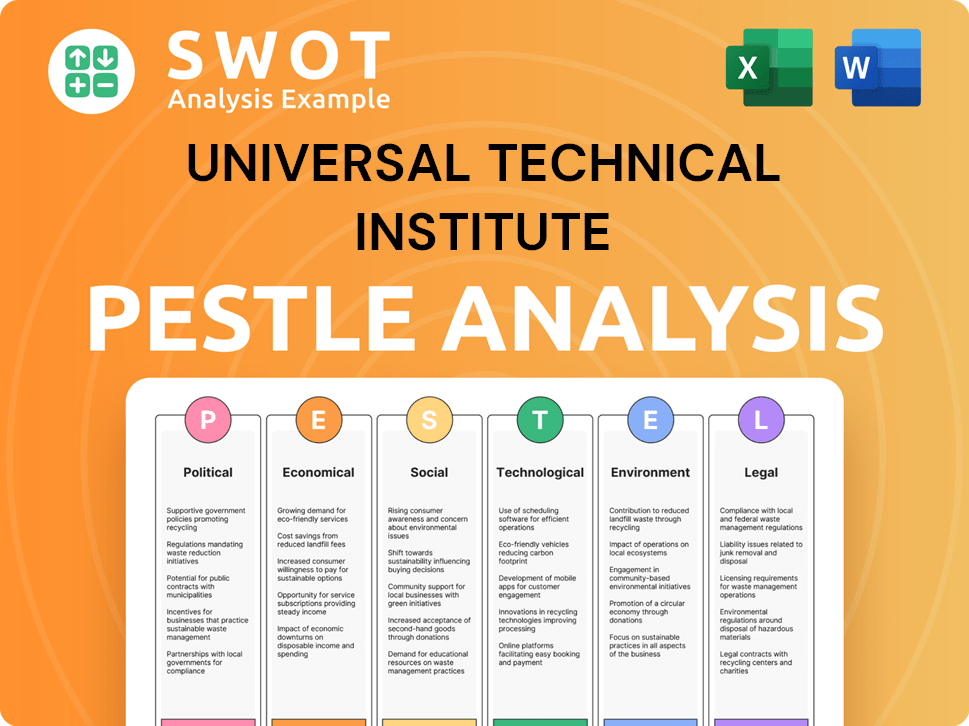
What Is Universal Technical Institute’s Growth Forecast?
The financial outlook for Universal Technical Institute (UTI) in fiscal year 2025 is promising, reflecting strong growth and strategic initiatives. The company's performance in fiscal 2024 set a solid foundation, with significant increases in revenue, net income, and adjusted EBITDA. This positive momentum is expected to continue, driven by increased student enrollments and expansion plans.
UTI's strategic focus on expanding its programs and campus network is a key driver of its financial projections. The company's commitment to providing high-quality technical education and aligning its programs with industry demands positions it well for sustained growth. The financial guidance for fiscal 2025 indicates a clear path toward achieving its long-term strategic goals.
The company's 'North Star Strategy' aims for a 10% revenue CAGR and an expanded Adjusted EBITDA margin. This strategic vision, coupled with the company's financial discipline, should drive value creation for stakeholders. For further insights into the company's performance and future, you can explore the information provided by Owners & Shareholders of Universal Technical Institute.
In fiscal 2024, UTI reported full-year revenue of $732.7 million, a 20.6% increase compared to the previous year. Net income reached $42.0 million, a substantial increase of 240.9% year-over-year. Adjusted EBITDA was $102.9 million, up 60.1%, and total new student starts were 26,885, an increase of 18.9%.
For fiscal year 2025, UTI anticipates revenue between $825 million and $835 million. Net income is projected to be between $56 million and $60 million, with diluted earnings per share expected to be between $1.00 and $1.08. Adjusted EBITDA is expected to range from $124 million to $128 million, and new student starts are forecast to be between 29,000 and 30,000.
Capital expenditures for fiscal 2025 are estimated at approximately $55 million, mainly for new campus launches and program expansions. As of March 31, 2025, UTI had $96 million in cash and cash equivalents. Total available liquidity as of September 30, 2024, was $230.9 million, providing financial flexibility.
UTI's 'North Star Strategy' aims for a 10% revenue CAGR and aims to expand Adjusted EBITDA margin to nearly 20% through fiscal 2029. The company projects revenue could potentially exceed $1 billion by the end of 2029, demonstrating a commitment to sustained growth and profitability.
Universal Technical Institute Business Model Canvas
- Complete 9-Block Business Model Canvas
- Effortlessly Communicate Your Business Strategy
- Investor-Ready BMC Format
- 100% Editable and Customizable
- Clear and Structured Layout
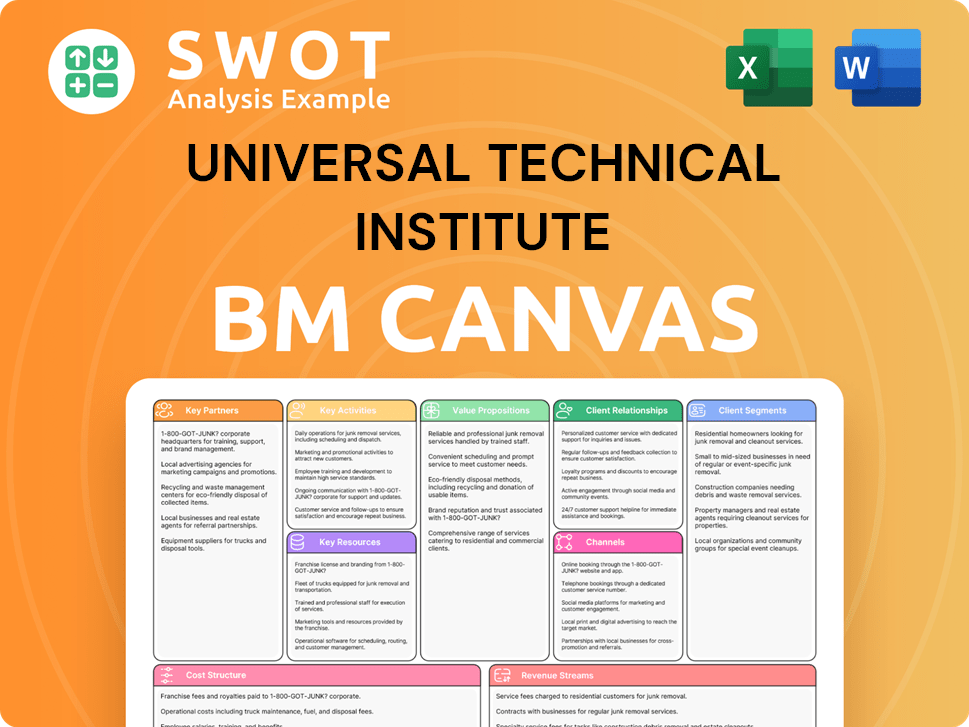
What Risks Could Slow Universal Technical Institute’s Growth?
The growth strategy of Universal Technical Institute (UTI) faces several potential risks and obstacles. These challenges range from regulatory scrutiny to market competition and operational hurdles. Understanding these risks is crucial for assessing the company's long-term viability and investment potential.
One of the primary risks stems from the perception and regulatory environment surrounding for-profit education. Changes in federal student financial assistance programs or legislative actions could significantly impact the company's funding and operations. Furthermore, the company's reliance on specific industry sectors creates vulnerabilities to economic shifts and technological advancements.
UTI's growth strategy and future are significantly influenced by the evolving landscape of technical education. The company must navigate several potential risks to achieve its goals. The following sections delve into the specific challenges and obstacles UTI faces.
For-profit education institutions like Universal Technical Institute face constant scrutiny. In 2024, a significant portion of potential students, approximately 67%, express skepticism about for-profit schools. This perception can affect enrollment. The industry also deals with high accreditation scrutiny and increasing regulatory compliance costs.
Competition from community colleges poses a challenge due to lower tuition costs. Community colleges typically charge between $10,000 to $15,000, significantly less than UTI's average tuition of $33,000 to $45,000 in 2024. This cost disparity can impact enrollment decisions for prospective students. The market is also influenced by employment trends within the automotive and transportation sectors.
UTI's business model is heavily tied to employment trends in the automotive and transportation sectors. Automotive programs account for about 72% of program enrollments. Projected job growth in the automotive sector is around 2% annually. Economic downturns or shifts in industry demand, such as the rise of electric vehicles, could impact enrollment and graduate outcomes.
Operational risks include the ability to successfully open and operate new schools or programs. Integrating acquisitions can also present challenges. Supply chain vulnerabilities could affect the availability of equipment for hands-on training programs. Rapid technological disruption in education necessitates continuous adaptation to stay competitive.
Changes in federal student financial assistance programs, including Title IV Program regulations, or legislative initiatives related to veterans' benefit programs, could impact the company's funding and operations. Dependence on these programs makes UTI susceptible to policy changes. The availability and terms of student loans are also crucial for student enrollment.
The rapid pace of technological change in education requires continuous adaptation. UTI must invest in technology and update its curriculum to remain competitive. The rise of online learning and virtual reality training could reshape the educational landscape. Staying current with industry advancements is essential for maintaining program relevance.
To address these risks, UTI is implementing strategies such as diversifying program offerings and expanding its geographic reach. The company's "North Star Strategy" outlines these initiatives. Strong industry relationships are also maintained to ensure curriculum relevance and student employment outcomes. For more details, you can read about Revenue Streams & Business Model of Universal Technical Institute.
Economic downturns and shifts in industry demand can significantly affect UTI. The automotive sector's health directly influences enrollment and job placement rates. Understanding and adapting to these economic factors is essential for long-term sustainability. UTI's ability to respond to changing market needs will determine its success.
Universal Technical Institute Porter's Five Forces Analysis
- Covers All 5 Competitive Forces in Detail
- Structured for Consultants, Students, and Founders
- 100% Editable in Microsoft Word & Excel
- Instant Digital Download – Use Immediately
- Compatible with Mac & PC – Fully Unlocked
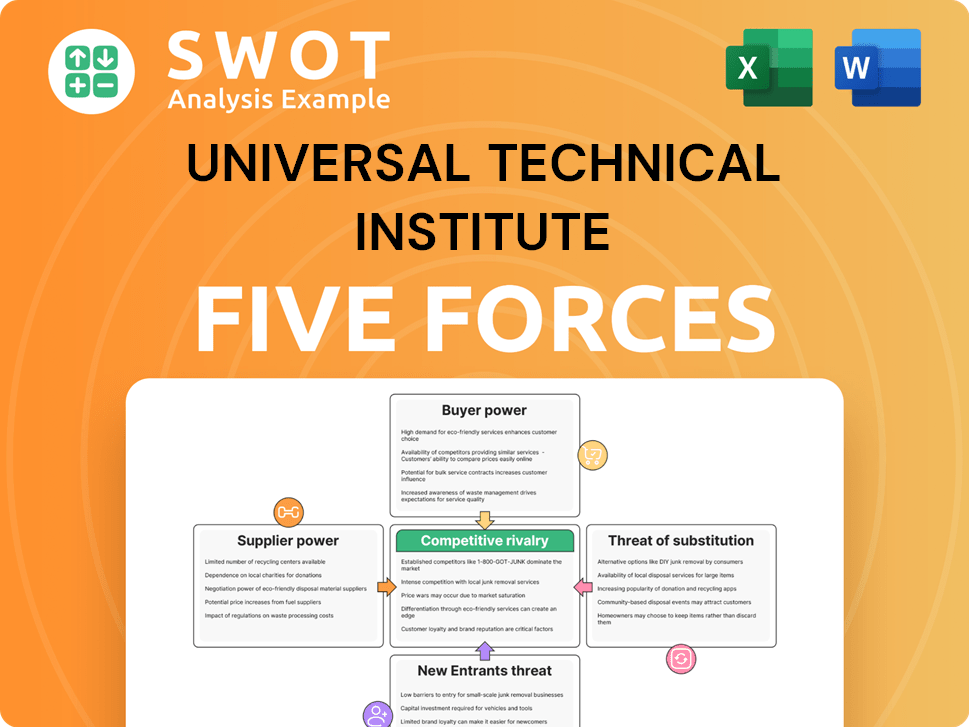
Related Blogs
- What are Mission Vision & Core Values of Universal Technical Institute Company?
- What is Competitive Landscape of Universal Technical Institute Company?
- How Does Universal Technical Institute Company Work?
- What is Sales and Marketing Strategy of Universal Technical Institute Company?
- What is Brief History of Universal Technical Institute Company?
- Who Owns Universal Technical Institute Company?
- What is Customer Demographics and Target Market of Universal Technical Institute Company?
Disclaimer
All information, articles, and product details provided on this website are for general informational and educational purposes only. We do not claim any ownership over, nor do we intend to infringe upon, any trademarks, copyrights, logos, brand names, or other intellectual property mentioned or depicted on this site. Such intellectual property remains the property of its respective owners, and any references here are made solely for identification or informational purposes, without implying any affiliation, endorsement, or partnership.
We make no representations or warranties, express or implied, regarding the accuracy, completeness, or suitability of any content or products presented. Nothing on this website should be construed as legal, tax, investment, financial, medical, or other professional advice. In addition, no part of this site—including articles or product references—constitutes a solicitation, recommendation, endorsement, advertisement, or offer to buy or sell any securities, franchises, or other financial instruments, particularly in jurisdictions where such activity would be unlawful.
All content is of a general nature and may not address the specific circumstances of any individual or entity. It is not a substitute for professional advice or services. Any actions you take based on the information provided here are strictly at your own risk. You accept full responsibility for any decisions or outcomes arising from your use of this website and agree to release us from any liability in connection with your use of, or reliance upon, the content or products found herein.